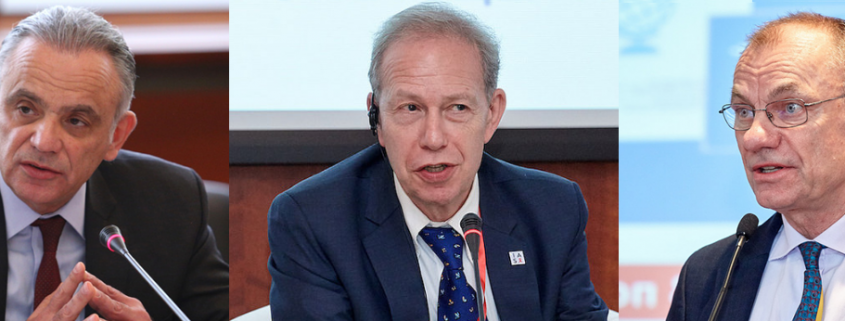Interviews with the speakers of EECAAC-2018 1st Organizing committee meeting

Luiz Loures
UNAIDS Deputy Executive Director, Assistant Secretary-General of the United Nations
- It’s been a year since the global Community adopted Fast-Track strategy to end the AIDS epidemic. What changes have you seen so far? How do the countries mobilize to achieve the targets?
A lot has changed in terms of the global context. I have witnessed important transitions in the UN and in specific countries. I’ve seen different agencies and organizations that are key to AIDS response strengthen their leadership. We have more evidence of progress – recent studies made by PEPFAR show that things are going pretty well for the countries of Sub-Saharan Africa heavily affected by HIV like, for example, Zimbabwe, Malawi. People are coming back to schools, to work, to leading a normal life – all thanks to the access to treatment and strong community response. On the other hand, evidence shows that the epidemic continues to grow in the most vulnerable populations – global MSM community, sex workers, transgenders. Today we see a paradox – we can’t put an end to the epidemic without fixing this problem first.
- What’s your opinion on travel restrictions for foreign citizens living with HIV? How do they affect the AIDS response?
There is no place for travel restrictions in AIDS response as there is no reason for such restrictions to exist in the first place. The epidemiology of HIV is clear – restricting people to travel will not prevent the spread of infections. It’s quite on the contrary. The first response from the people who become subject to those restrictions is to go underground. They travel anyway but they travel illegally. It’s much more difficult for them to have access to prevention, treatment and other services. I see positive changes in the region of Eastern Europe and Central Asia in terms of recent developments and I do hope that by the next EECAAC travel restrictions are history in this part of the world.
- During the first meeting of EECAAC Organizing Committee you stressed the importance of “building bridges” between the upcoming AIDS-2018 conference in Amsterdam and EECAAC-2018 in Moscow. How do you envision this cooperation?
It’s already happening. Such a strong presence of Dutch colleagues in the preparatory discussions for EECAAC is an extremely good sign. The Dutch Ambassador in Moscow is interested in promoting a meeting that will bring together Russian managers, leaders, experts along with their Dutch counterparts. This initiative has been supported by the South African and Brazilian ambassadors. In its core lies the idea of creating a unique space for strong international cooperation in response to AIDS. That’s what we need right now. The history has shown that tackling global challenges is most efficient through international cooperation. It’s no different when it comes to our conferences. There are several options in terms of joint sessions or joint symposiums, but they’re also two factors that can’t be ignored. The first one is participation. We need to make sure that EECAAC has a strong presence of the colleagues from the Netherlands and beyond. At the same time, substantial participation of experts from Russia and other countries of Eastern Europe and Central Asia in AIDS-2018 is also vital. The language is the second thing, we should not underestimate. It’s essential. Despite the fact that people speak different languages, they should have no problem communicating with each other.

Peter Reiss
Co-Chair of the AIDS-2018 conference, Professor of Medicine at the Academic Medical Center (AMC), University of Amsterdam
- What are your expectations from the AIDS-2018 conference? How do you picture it?
We expect to bring together lots of people from all over the world and we hope Amsterdam is attractive enough to come to. As you know, one of the objectives of the conference is to shine a spotlight on the region of Eastern Europe and Central Asia. We are going to make sure that people from this region can attend our event. Ultimately, if you look beyond the conference, we hope it has a carryover effect and improves HIV treatment, care and prevention in the region.
- What kind of contribution would you like to see from the Eastern Europe and Central Asia delegates?
We expect their broad participation. The typical nature of these international AIDS conferences is that it’s not just about scientists, but it’s really about bringing together everybody who is concerned about the problem of HIV. And of course, the community of people living with HIV and people who are at risk of acquiring HIV are put at the center of it all. We want them to participate as well. We welcome scientists, clinicians, epidemiologists, policy makers, activists and representatives of vulnerable populations.
- The Netherlands made a breakthrough in terms of bringing down the number of new HIV cases. What lies behind this success?
In the early days of the epidemic harm reduction was put in place with needle exchange and methadone. I think that helped because if you look at our latest figures we really see no new infections amongst injecting drug users. Our main problem at the moment is newly diagnosed infections in migrant populations that are in the Netherlands. The number of new HIV infections is going down but it’s not going down fast enough. We want it to get down even further. I think what has made that happen so far is treatment availability. I can’t prove it but I think it’s suggestive that if people have access to treatment earlier and start ART earlier then it’s probably what’s driving this decline. Unfortunately, we still fail to reach certain populations that we should reach. That’s why what we are focusing on right now – for instance, in the city like Amsterdam – is the development of new ways to interact with these people. The other big problem that we see in certain populations is that people present late. 40% of newly diagnosed individuals in the country and in Amsterdam are late presenters. This should not happen. Obviously, they haven’t been tested for HIV before, they show up in the emergency room, they are sick and turn out to be HIV-positive. The question is whether we are reaching them or there is stigma that prevents those people from getting tested. We need to work more closely with these communities and see how we can improve the situation. It’s not perfect yet, but we are definitely on the right path.

Gottfried Hirnschall
Director of the HIV/AIDS Department and the Global Hepatitis Programme (GHP), WHO
- New WHO recommendations mention self-testing as an important component of HIV prevention. Are there any countries that have already integrated or think of integrating self-testing as part of their National HIV response strategy?
Self-testing is a very promising option for the future. It makes testing easier for people in general. In ideal situation you know what to do in case of a positive result – go to a clinic or a healthcare provider. A number of countries, such as France and the United Kingdom are starting to use self-testing and to move towards its introduction into the national policies. We have been working together with UNITAID to introduce this on a pilot basis in some African countries. More and more countries want to see how this experience goes and how it can fit into their specific context. Self-testing is also appealing in the situations when you have people who are discriminated against, possibly even criminalized. They have certain concerns about visiting healthcare institutions, but with self-testing they can easily learn their HIV status in the privacy of their homes.
- For the past couple of years the world has seen the appearance of new, effective but often costly ARV drugs. At the same time, many countries face the problem of insufficient ART coverage. Where do you see the balance between expanding access to treatment and getting effective therapy for a reasonable price?
First of all, we have achieved good coverage in countries, specifically in sub-Saharan Africa, that have very high numbers of people living with HIV. We have been able to considerably bring down the prices partly because of the generic production, generic competition and local production. Low prices do not mean that these drugs are low quality or that the regiments are suboptimal. There is a process in place to actually ensure the quality of these generic drugs. We call it “pre-qualification process”. South Africa, for example, is now treating more than two million patients with very good drugs. The regimens are cheap and have high success rates. In some other countries, particularly middle and high-income, it is more challenging to bring down the prices to the same levels because of the patent protection, intellectual property issues, etc. Still though, some countries were able to do that. Even in Russia we’ve recently seen the prices come down. Not to the same level as we have seen in low-income countries, but it is still a visible price reduction.
- What does the concept of “patient-centered care” mean for you? What role does it play in shaping new WHO recommendations?
There is really a strong push for WHO as well as for the healthcare providers to look at the patient’s needs from the patient’s perspective. When a patient comes to you, very often he or she doesn’t have just one symptom. Somebody who has HIV, for example, in many instances actually has other conditions. There could be a hepatitis infection or a TB co-infection, mental health issue or a psychosocial issue, cardiovascular and so on. So what we mean by “patient-centered care” is to look at what really are the issues with the patient’s health and provide him with treatment in a most holistic manner. For example, when somebody comes with HIV don’t just give him ART, look at the big picture. From the WHO perspective we are searching for the ways to bring together specific services on treatment and prevention of HIV, TB, and hepatitis. We hope that this will put forward the concept of care that centers around the patient and focuses on his needs.



